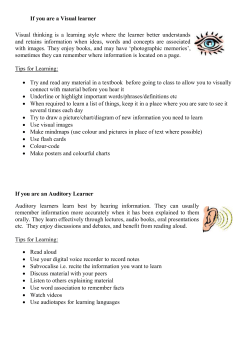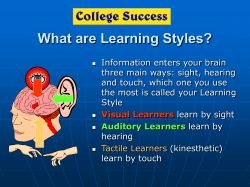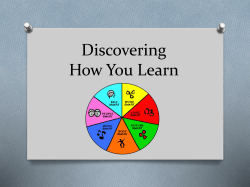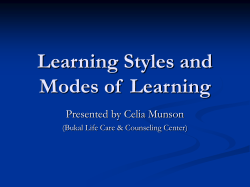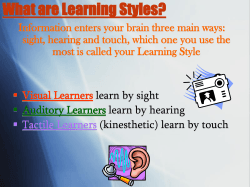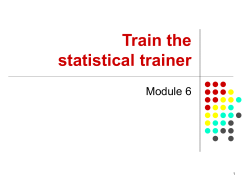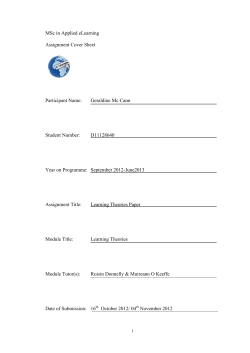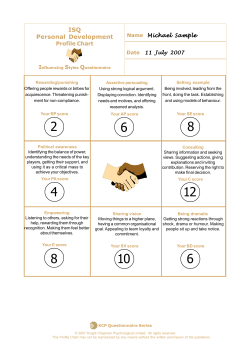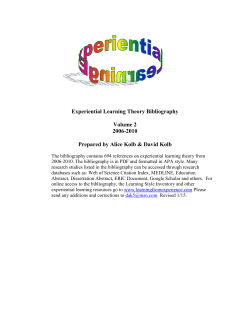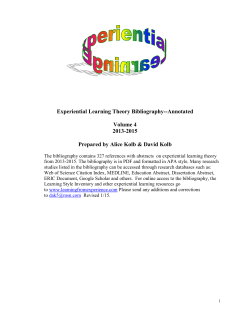
Document 387572
1. 2. 3. 4. 5. To understand the impact of learning styles on the supervisory relationship. Review learning theories. Identify types of learning styles. Identify your own learning modality: visual, auditory, reading, kinesthetic. Understand ways to optimize student learning. Research indicates that learning style differences have an influence on both students and field instructors’ perceptions of the field placement (Itzhaky & Eliahou, 2001, Raschick, Maypole, & Day, 1998). These findings suggest that the relationship between field instructors and students can be enhanced by recognizing and responding to learning styles early in the placement. Adults have a need to be self directed in learning activities. Adults prefer to learn through experience, rather than acquiring knowledge passively. Adult learners are motivated to learn what they perceive to have real value and applicability for their lives. Adult learners must have immediate opportunities to practice the information they are given. • • • Adult learning theory (“andragogy”) is the art and science of helping adults learn. A conducive learning environment is connected to the quality of learning achieved. Essential conditions for learning are: “A climate that promotes ‘informality, mutual respect, physical comfort, collaboration rather than competition, openness, authenticity, trust, non-defensiveness, and curiosity” (Knowles,1972, cited in Hendricks, Finch, & Franks, 2005). • Time – are field instruction times scheduled, consistent, private, uninterrupted? • Space – the physical setting for field instruction. • Title/status – how do we choose to be addressed? How do we choose to address to students? • Information sharing and access to resources • Decision making – what is the decision making process like around assignments? Are self-monitoring and selfevaluation encouraged? Is reflexive discussion occurring? How realistic are goals that are set? Are expectations discussed openly? Is open discussion about student expectations encouraged? 1. 2. 3. Visual Auditory Kinesthetic According to the theorists, instructors need to present information using all three styles. This allows all learners the opportunity to become involved, no matter what their preferred style may be. 1. When you read, do you: A. Enjoy descriptive passages and visualize the scene B. Enjoy dialogue and hear the characters in your mind C. Prefer action scenes, but do not enjoy reading 2. When you learn something new, do you: A. Like to read instructions or see demonstrations B. Prefer verbal instructions C. Jump in and learn by doing it 3. When you are spelling an unfamiliar word, do you: A. Visualize the word in your mind B. Sound the word out as you spell it C. Write the word down first 4. When you want to relax, do you: A. Watch TV or read B. Listen to music C. Play a game or exercise ◦ 5. When you are concentrating, do you: A. Get distracted by messy surroundings B. Get distracted by noise C. Get distracted by activity around you 6. When you are trying to figure out how someone is feeling, do you: A. Look at their facial expressions B. Listen to the sound of their voice C. Look at their body movements 7. When you teach someone something new, do you: A. Show them what to do or write down instructions B. Tell them what to do C. Do it with them 8. When you compliment someone on their work, do you: A. Write them a note B. Tell them they did a good job C. Shake their hand or pat them on the back 9. When you are bored, do you: A. Look around or doodle B. Talk to yourself C. Move around or fidget 10. When you need to remember something, do you: A. Write it down B. Say it to yourself over and over C. Think about it while moving around 11. When you are giving directions, do you: A. Draw a map B. Give clear and detailed instructions C. Point and use body language to explain the directions Now add up your answers! A ___________ B ___________ C ___________ A= Visual Learner B= Auditory Learner C= Kinesthetic Learner There are three basic types of learning styles. The three most common are visual, auditory, and kinesthetic. To learn, we depend on our senses to process the information around us. Most people tend to use one of their senses more than the others. This quiz helps you determine which of these learning styles you rely on the most. It is not unusual to use different learning styles for different tasks. Adapted from Rose, C. (1985). Accelerated learning. New York: Dell Publishing. Visual Learners Learn best from what they can see or read. Prefer written instructions. Prefer visual aids. Learn how something is done through observation of others. Teaching Strategies Use visual materials. Demonstrate how something is done. Allow opportunities to observe before doing. Provide written instruction. Encourage student to take notes. Minimize noise, easily distracted. Auditory Learners Need to hear information in order to retain it. Prefer verbal instructions over written materials. Prefer to discuss ideas aloud in order to process information. Enjoy group discussions and activities. Teaching Strategies Rephrase important points to increase understanding. Have student paraphrase. Encourage discussion & invite questions. Remember that students may not tell you they don’t understand. Have student discuss roles with other colleagues. Kinesthetic Learners Prefer to learn through experience. Obtain greatest benefit by participation. Remember information that they experience directly. Enjoy acting out or recreating situations,.i.e. role playing. Enjoy hands-on activities that involve active, practical participation. Teaching Strategies Quickly engage student in agency activities. Use role plays. Allow client contact early on as it will reduce anxiety. Develop assignments that are interactive, i.e. have student give presentation. What is your learning style? How do you think this influences the way that you approach teaching your student? Now that you understand the characteristics of these learning styles, it is important to recognize and respond to the learning needs of your student, particularly when your student has a different learning style then your own. There are many different theories and models of learning styles in the professional literature. Some overarching frameworks that explain how we acquire knowledge are Constructivism, Behaviorism, Humanism, Cognitivism, and Positivism. Some individual theorists we would like to mention are: Kolb (1984) Experiential Learning Reynolds (1985) Five Stage Model of Learning Gardner (1993, 2004) Theory of Multiple Intelligence Sodhi & Cohen (2012) Embodied Knowledge Based on the assumptions that people learn from their experiences. The four stages of experiential learning involve a unidirectional circular process that moved from: 1. 2. 3. 4. Stages of Learning The Learning Circle Learning Style Concrete Experience Reflective observation Abstract conceptualization Active experimentation Reflective learner (the Observer) Operational learner (the Doer) Conceptual learner (the Thinker) Intuitive learner (the Feeler) An individual learner may enter the learning cycle from any one of four distinct positions. These entry points are associated with a corresponding learning style, as noted above. Concrete Experience Reflective Observation Active Experimentation Abstract Conceptualization Reflective learner (the Observer) Takes everything in, looks at many pts. Of view, organizes material into a meaningful order. Strategy: allow these students to shadow or sit in on sessions as a way of beginning. Operational learner (the Doer) Learns best through direct action. Anxious to get busy right from the start. May need help to deal with the slow process of change. Conceptual learner (the Thinker) ◦ Learn through literary and informational sources. ◦ Thrive on learning theoretical approaches to problem solving. ◦ Tend toward a Q & A probing format in sessions; benefit from practicing open-ended questions and interventions that promote exploration. ◦ It may take time to discuss feelings. Intuitive learner (the Feeler) ◦ Learn best through the use of their senses, particularly their feelings and emotions. ◦ Need to move from personalized experience to reflection and conceptualization of the meaning of the experience. ◦ Strength: ability to connect with people, prefer to learn in the “here-and-now.” ◦ May find themselves feeling along with their clients. This study examined the learning styles of students in social work classes at Norfolk State University. Kolb's Learning Style Inventory was administered to identify each student's dominate learning style. The theoretical underpinning is experiential learning. The results indicated that diverging and accommodating learning styles occurred most often. Students with these styles learn best in classes where activities include lectures, role playing exercises, discussions, opportunities to practice skills, and reflection (Massey, Kim, & Mitchell, 2011). “The first largest learning style was Diverging style, students who grasp experience through Concrete Experience (CE) and transform it through Reflective Observations (RO)” “Second largest learning style of students in this study was the Accommodating style, which is characterized by Active Experimentation (AE) and Concrete Experience (CE)” Overly simplistic, (Jarvis, (1987) in Miller et al. (2005). Key elements of experiential learning necessary in field education are missing from Kolb’s learning model, especially the role of relationship (Miller, et al. 2005). Miller et al. (2005) studied how students and field instructors experience “learning” in field practicum. The goal of the study was to develop greater understanding about the learning process in order to better prepare field instructors to engage in…teaching of students. Missing: ◦ Memorization ◦ Affective, emotional elements ◦ Reflection element ◦ Relationship ◦ Social Contexts ◦ Does not take into account the demands of the specific profession “Awareness of these stages provides guideposts to the potential stumbling blocks along the way (Fredericks et al., 2005).” New students in field Stage of acute consciousness of self High anxiety, feel they cannot succeed, fight or flight, feelings of inadequacy The sink or swim stage Provide support, constructive criticism Approval seeking, dependence Progress and disillusionment when there are setbacks The stage of understanding a situation without the power to control one’s own actions or activity in it The stage of relative mastery Can both understand and control activity required Characterized by the integration and practice Called in to offer consultation and teach others The stage of learning to teach what one has mastered Gardener (2000) spent thirty years studying brain research on intelligence and human potential. His theory is based on the idea that everyone learns differently, and everyone has multiple intelligences and one specific method of teaching cannot be applied to all learners. The Multiple Intelligence Theory identifies believes that there are at least eight ways in which students can learn: Musical/Rhythmical Naturalist\Intrapersonal Bodily/Kinesthetic Verbal/Linguistic Logical/Mathematical Interpersonal and Visual/Spatial “Traditionally, research in adult education have focused on cognitive ways of knowing. There has been minimal focus on non-cognitive ways of knowing, including embodied knowing. The purpose of this qualitative study was to understand how social workers incorporated embodied knowing into their social work practice. Participants identified internal reactions in social work interactions and described how they processed these somatic sensations to guide their practices” (Sodhi & Cohen, 2012 p.1). An integrated approach using a mind-body awareness. Avoids duality between mind (empirical) and body (intuitive). Example: student who has dealt with trauma (physical, emotional and/or sexual). How might embodied knowledge help this student learn? Fortune, McCarthy, & Abramson, faculty in the School of Social Welfare, University at Albany, Sate University of NY: studied the relationship of learning activities to quality of field instruction, satisfaction, and performance among MSW students. • Findings suggest importance of students’ need both doing and understanding. • Need to distinguish between perceptions from performance. Awareness of your own learning style and an understanding of your student’s learning style can enhance the learning process. Field instructors should actively involve students in the creation of learning activities and encourage autonomy in accomplishing tasks. Remember that adult learners need immediate opportunities to practice the information they are given. Students are more invested when they believe that what they are learning at the agency is going to have a practical application for their lives after graduation. ◦ Adapted from Dettlaff, A. J. ( 2003). From mission to evaluation: A field instructor training program. Council on Social Work Education, Inc. : Alexandria, VA. This concludes the content for this training module. ◦ In order to receive APU field instructor training credit, please close the PowerPoint slides and access the Module 4 Post Test on the apu.edu/msw-training/home page. ◦ The post test will ask for your contact information. ◦ To receive a training certificate for eight hours (required for new field instructors), the Fall training modules, in their entirety, must be completed. Please note that continuing education units (CEUs) are only offered at live APU field instructor trainings. Dettlaff, A. J. ( 2003). From mission to evaluation: A field instructor training program. Council on Social Work Education, Inc. : Alexandria, VA. Dunn, R, & Dunn, K (1978). Teaching students through their individual learning styles: A practical approach. Reston, VA: Reston Publishing Company. Itzhaky, H., & Eliahou, A. (2001). The effect of learning styles and empathy on perceived effectiveness of social work student supervision. Clinical Supervisor, 20(2), 19. Kolb, D. (1984). Experiential learning: Experience as the source of learning and development. Englewood Cliffs, NJ: Prentice-Hall. Gardener, H. (2004). Frames of mind: The theory of multiple intelligences. New York, NY: Basic Books. Reynolds, M. (1998). Reflection and critical reflection in management learning. Management Learning, 29(2), 183-200. doi:10.1177/1350507698292004 University of Pennsylvania (2009). Visual learners convert words to pictures in the brain and vice versa, says psychology study. Science Daily. Retrieved July 10, 2011, from http://www.sciencedaily.com/releases/2009/03/090325091834.htm Massey, M. G., Kim, S.-H., & Mitchell, C. (2011). A Study of the Learning Styles of Undergraduate Social Work Students. Journal of EvidenceBased Social Work, 8(3), 294–303. doi:10.1080/15433714.2011.557977 Sodhi, M. K., & Cohen, H. L. (2012). The manifestation and integration of embodied knowing into social work practice. Adult Education Quarterly, 62(2), 120–137. doi:10.1177/0741713611400302
© Copyright 2025
